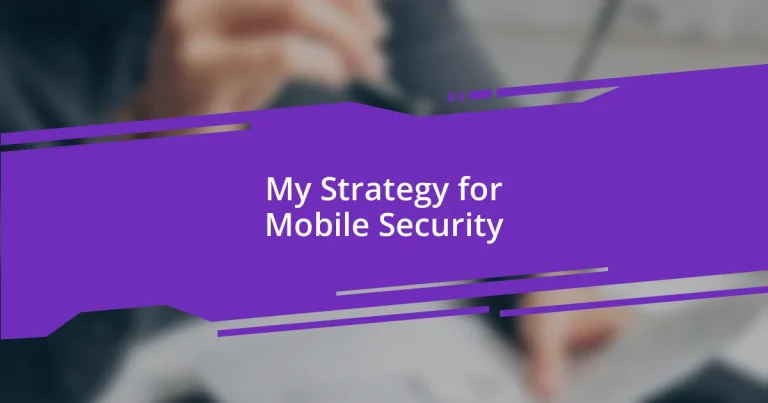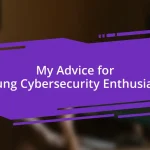Key takeaways:
- Mobile security risks, including app permissions and public Wi-Fi usage, can lead to serious data breaches and identity theft.
- Implementing strong password practices and multi-factor authentication (MFA) can significantly enhance security and minimize unauthorized access.
- Regular software updates, using trusted security applications, and practicing safe browsing habits are essential for maintaining mobile security and protecting personal information.
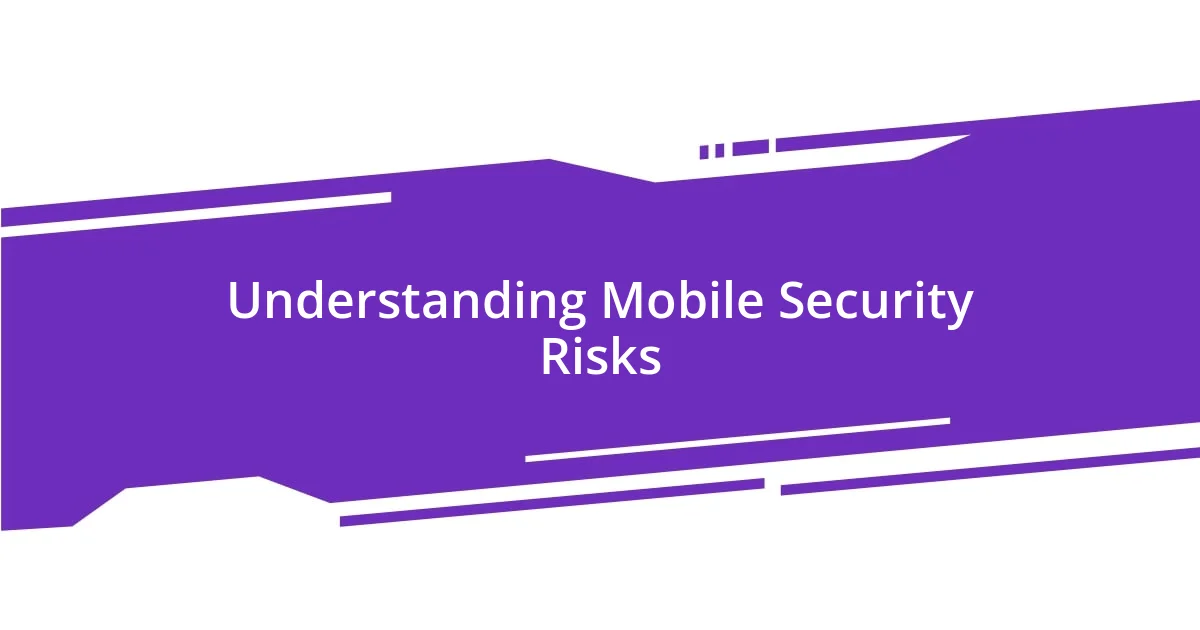
Understanding Mobile Security Risks
Mobile security risks are often underestimated, but they can have a profound impact on our daily lives. I remember a time when a friend’s phone was hacked, giving someone full access to their personal data. It felt invasive and terrifying—an experience that made me acutely aware of how vulnerable we can be.
Consider this: how often do you download apps without checking their permissions? I’ve been guilty of this myself. Apps can access far more than we realize, sometimes leading to data leaks or even identity theft. The realization that what seems harmless may actually expose us to threats is sobering, isn’t it?
With the rise of public Wi-Fi, the risks multiply. I’ve often seen people casually surfing the web in coffee shops, completely unaware that they could be targeted by hackers on the same network. It raises a serious question: is convenience worth the potential compromise of our personal information? In my experience, taking extra precautions is always worth it.
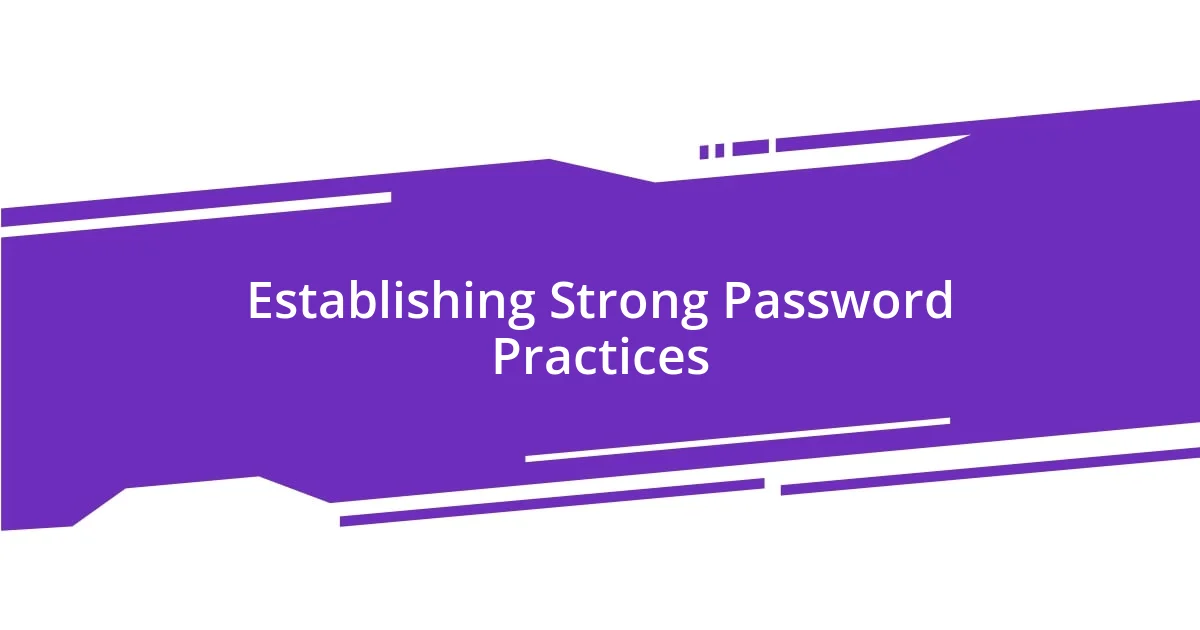
Establishing Strong Password Practices
Establishing robust password practices is essential for safeguarding our mobile devices. I’ve watched friends struggle to remember complex passwords, only to rely on simple ones like “123456” or “password.” It’s such a common mistake—and a dangerous one. I once had a small scare when my email got hacked simply because my password was too predictable. The panic I felt as I changed my password and enabled two-factor authentication was a wake-up call.
Here are some tips for creating strong passwords:
- Use a mix of characters: Incorporate uppercase and lowercase letters, numbers, and symbols.
- Make it lengthy: Aim for at least 12 characters to increase security.
- Avoid personal information: Don’t use easily guessed details like birthdays or names.
- Use unique passwords for different accounts: This limits the damage if one password is compromised.
- Consider a password manager: These tools can help generate and store complex passwords securely.
By investing time in strong password practices, we not only protect our accounts but also enjoy peace of mind.
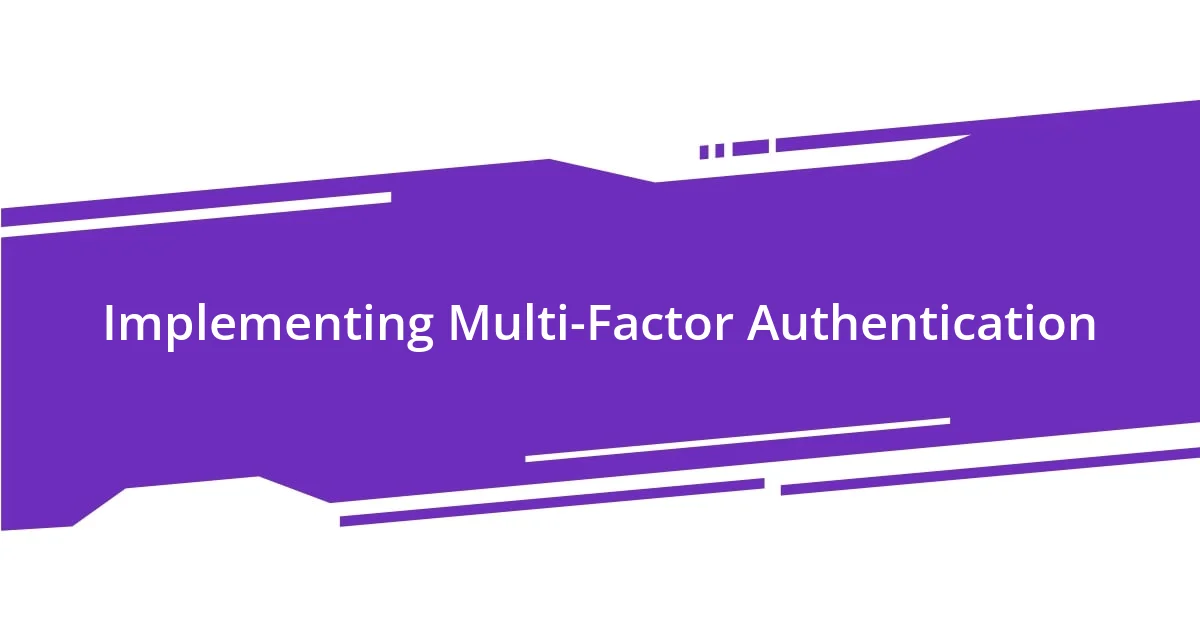
Implementing Multi-Factor Authentication
Implementing multi-factor authentication (MFA) is a game changer in mobile security. I vividly remember when I first activated MFA on my personal bank account. Initially, it felt like an extra hassle, but soon I realized that the security it provided far outweighed any inconvenience. The peace of mind I gained from knowing that my account would require both my password and a one-time code sent to my phone was invaluable.
It’s crucial to understand that some mobile apps offer different types of MFA, enhancing our security levels in various ways. For example, SMS-based codes are common, but I sometimes find myself grappling with the fact that this method can be susceptible to SIM swapping attacks. In contrast, authenticator apps like Google Authenticator are more secure, generating time-sensitive codes without relying on a third-party network. Which method do I prefer? I lean toward authenticator apps for their added layer of security, a choice rooted in personal experience.
Ultimately, implementing multi-factor authentication can significantly reduce the risk of unauthorized access to our sensitive information. Have I ever experienced a close call regarding my online accounts? Absolutely. One evening, I received a strange notification from an app suggesting a login from a different device. Thanks to MFA, I was alerted to the breach before any damage could be done. It drove home the importance of making this security step a priority in our digital lives.
| Authentication Method | Advantages | Disadvantages |
|---|---|---|
| SMS codes | Easy to set up | Vulnerable to SIM swapping |
| Authenticator apps | More secure, offline access | Requires app installation |
| Email codes | Convenient, familiar | Potentially less secure |
| Biometric authentication | Convenient and fast | Device dependent |
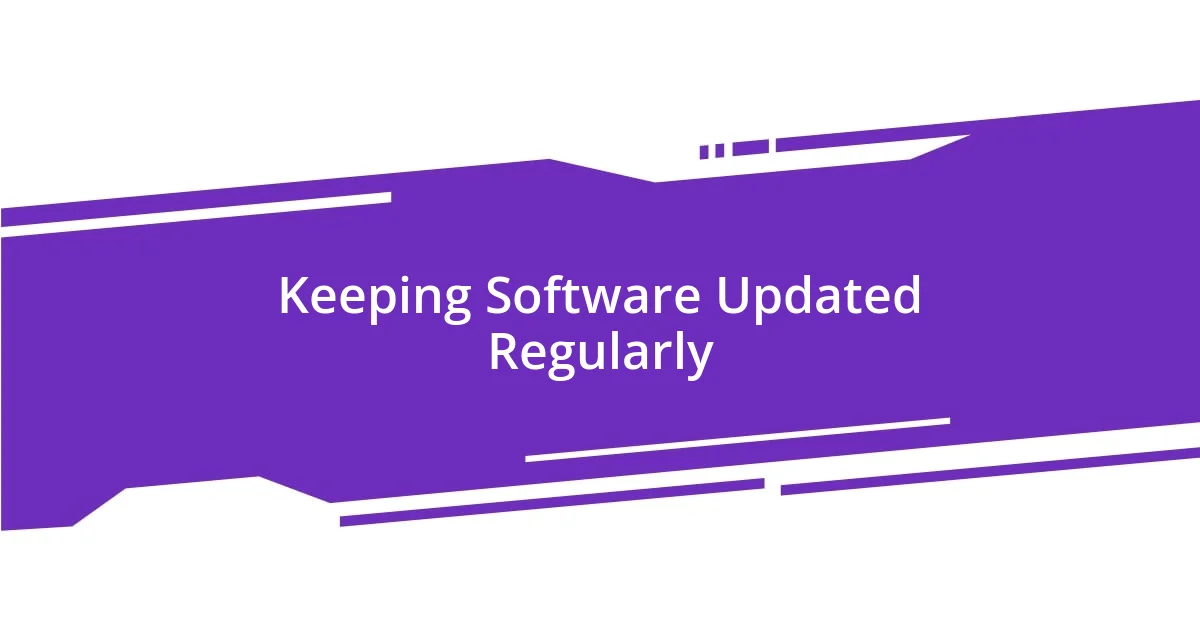
Keeping Software Updated Regularly
Keeping our software updated regularly is one of the simplest yet most effective ways to bolster mobile security. I can’t stress how many times I’ve overlooked an update notification, thinking it wasn’t a big deal, only to discover later that those updates contained crucial security patches. It’s a bit like ignoring a warning sign on a road; you never know when it might lead to a rough detour.
I remember a particularly frustrating incident when my favorite app malfunctioned after I delayed an update. It turns out that the new version included fixes for security vulnerabilities that hackers had quickly targeted. That experience taught me that getting into the habit of updating software can save us from potential headaches—and worse. So, what can we do to cultivate this habit? I set weekly reminders for updates, making it a part of my routine just like checking my email.
Let’s not forget the risk of using outdated apps or operating systems. Each time we forgo an update, we’re essentially inviting threats into our digital lives. Whenever I speak to friends about mobile security, I often ask, “Why take unnecessary risks?” The reality is, staying updated not only keeps our devices running smoothly but also ensures we’re equipped with the latest security measures to fend off potential attacks. It’s a small effort that delivers significant peace of mind.
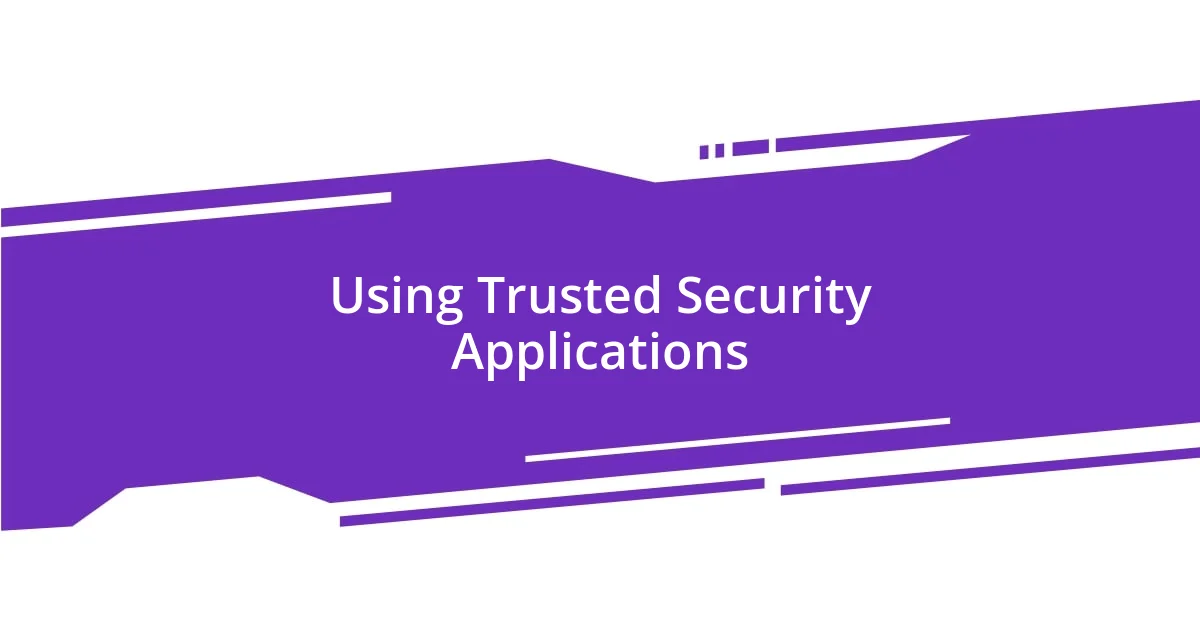
Using Trusted Security Applications
I’ve always found that using trusted security applications is a cornerstone of my mobile security strategy. When I first dabbled in the world of mobile security, I turned to a well-known antivirus application, thinking it would be enough. However, it wasn’t until I began exploring different trusted apps that I realized their unique features could vastly enhance my overall security. For instance, some apps come with privacy audits and app lock functions that add another layer of protection I didn’t even know I needed.
I also remember a moment when I was skimming through my phone and noticed a notification from my security app about a potential phishing attempt. How reassuring it was to have that proactive monitoring! In the past, I wouldn’t have thought twice about clicking on a link, but now I hesitate, reviewing the alert through my security app. This experience highlighted the importance of using applications that not only secure but also educate about potential threats, making me feel more empowered as a user.
When I discuss mobile safety with friends, I always wonder, “Why rely on guesswork when trusted apps can do the heavy lifting for us?” My go-to apps regularly update their databases with the latest threats, keeping my device safer while allowing me to focus on enjoying my phone rather than worrying about security breaches. When it comes to mobile security, I firmly believe that trusting the right applications can create a safeguard that allows us to use our devices with peace of mind.
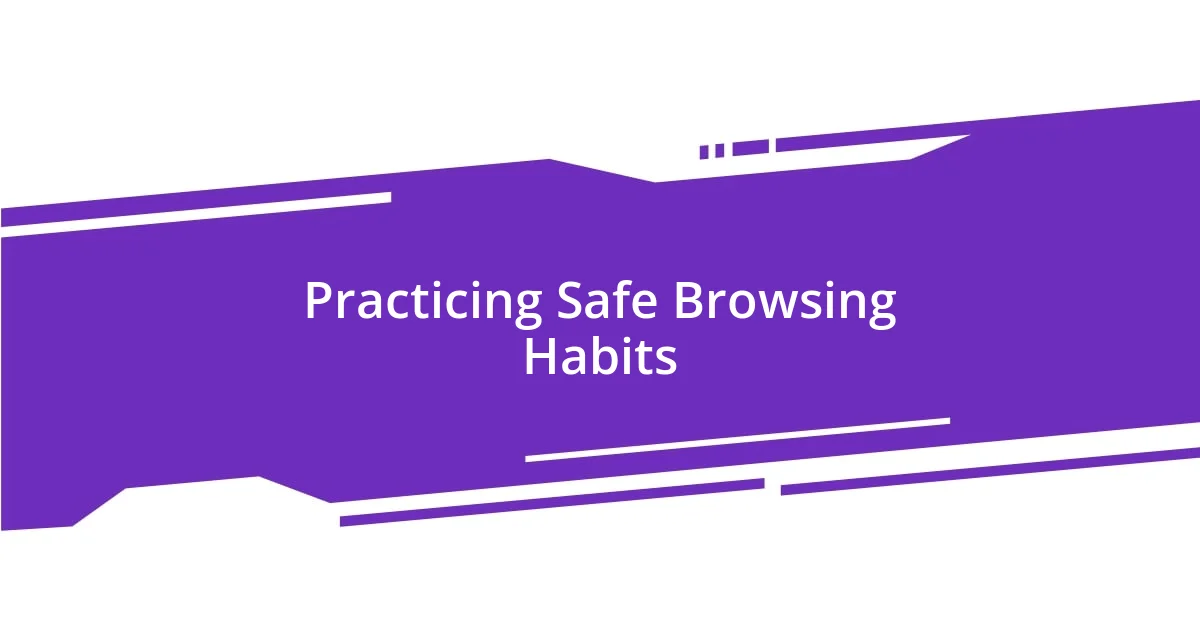
Practicing Safe Browsing Habits
Engaging in safe browsing habits is a fundamental aspect of mobile security that I’ve come to prioritize over time. I recall a time when I absentmindedly clicked on an enticing ad while scrolling through social media. It led me down a rabbit hole of sketchy websites and unsolicited pop-ups, a situation that left me feeling vulnerable and regretful. Now, I always take a moment to assess links before tapping—what looks harmless can often be a doorway to trouble.
I’ve also learned the importance of distinguishing between secure and non-secure websites. For example, I used to overlook the small “HTTPS” indicator in the browser’s address bar, dismissing it as a minor detail. However, after a close friend experienced a phishing scam due to overlooking this simple check, it became clear that every little detail matters. Now, I find myself scanning that address bar before entering any personal information, feeling a sense of control over my digital surroundings.
Beyond website checks, it’s also vital to be cautious with public Wi-Fi. One chilly afternoon, I settled into a cafe, eager to finish some work while connected to their free Wi-Fi. Luckily, a nagging feeling prompted me to use a VPN—a virtual private network—before browsing. It turned out to be a wise choice as I later learned about risks associated with unprotected connections. I often ask myself, “Is the convenience worth the potential threat?” I believe that by approaching our Internet use with mindfulness, we not only enhance our security but also cultivate a more confident and enjoyable browsing experience.
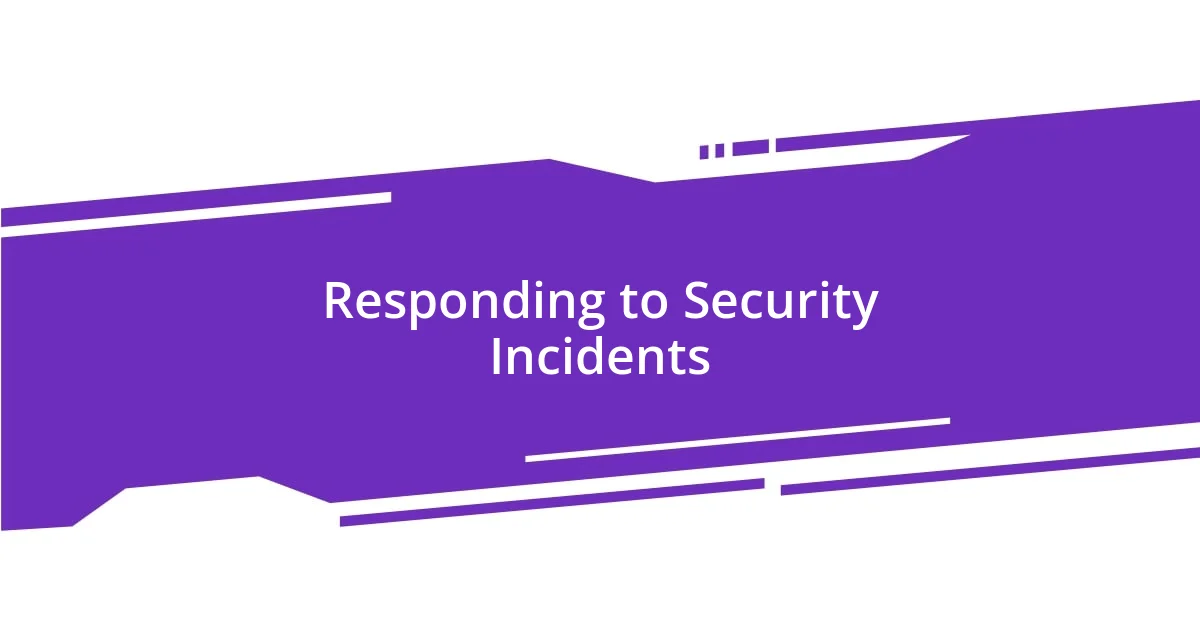
Responding to Security Incidents
When a security incident occurred on my mobile device, I learned the hard way just how crucial a swift response can be. One afternoon, I received a strange message, seemingly from a friend, containing a link. Curiosity got the better of me, and I clicked. Instantly, I felt a pang of dread when my phone started acting erratically. This moment emphasized the need for a predetermined action plan when faced with potential threats.
In that frantic moment, I recalled my strategy: the first step was to disconnect from Wi-Fi and mobile data immediately. It felt like a breath of fresh air, knowing I could halt potential data leakage. My instinct was to go through my security app and initiate a comprehensive scan. Watching the app work to identify any malicious software instilled a sense of control, which was oddly comforting amidst panic. Reflecting on that experience, I can’t help but wonder—how prepared are we for the unexpected?
After managing that scare, I realized it wasn’t just about acting swiftly, but also documenting what had happened. I took notes on the nature of the incident, how I responded, and the outcome. Writing down my experience helped me analyze what went wrong and made me feel more empowered. It serves as a reminder that while we can’t eliminate all risks, having a clear strategy to respond to security incidents can turn chaos into clarity. How about you? Do you have a plan in place for when things go sideways?












